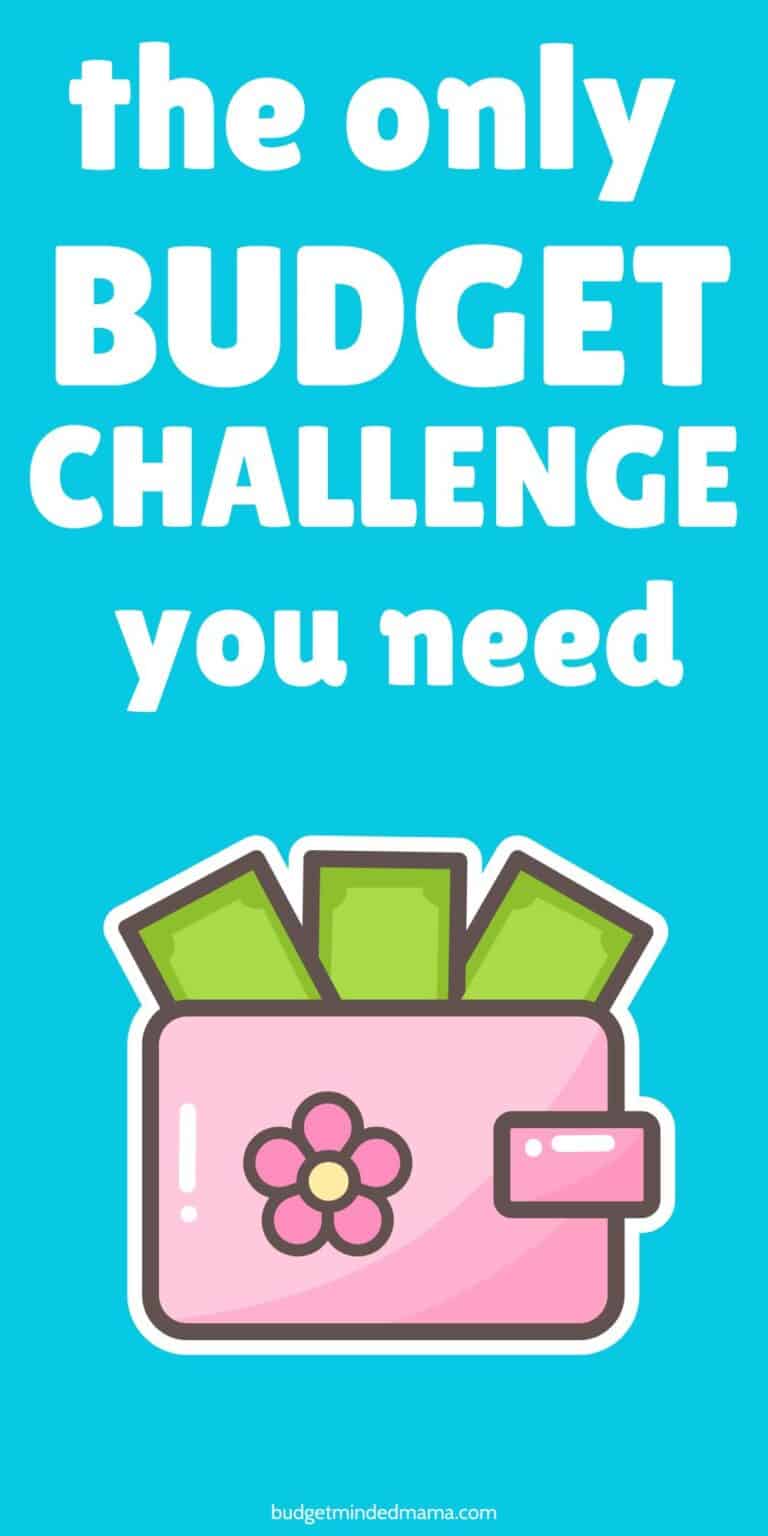Are you looking for a simple budget challenge in 2025?

I’ve got just the thing!
It’s a simple challenge that’ll help you get a handle on your finances without feeling overwhelmed.
I know budgeting can sometimes be stressful, but it doesn’t have to be.
And trust me, with little kids and going from two incomes down one I had to really figure out our budget for the long haul.
This challenge is designed to help you save money, no matter your financial situation.
I’m excited to walk you through it and help you feel more confident about your money.
By the end of it, you’ll have a fresh perspective on saving money and how to stick to your budget.
Let’s get started!
Bi-Weekly Budget Challenge Ideas

A bi-weekly budget challenge is a great way to take small, manageable steps toward improving your finances.
It breaks down your goals into bite-sized pieces, making it easier to stay on track and build up your savings.
It’s all about making steady progress and celebrating those mini victories along the way.
How to Set Realistic Bi-Weekly Budget Goals
When you’re starting out with a bi-weekly budget challenge, it’s important to set goals that feel achievable.
Think about what you want to accomplish over the next two weeks—maybe it’s cutting back on dining out or saving a set amount for a rainy day fund.
Be specific and keep your goals simple, so they don’t feel overwhelming.
Break things down into smaller tasks like tracking your expenses daily or planning meals for the week ahead.
This way, you can stay motivated and see your progress, which helps keep the momentum going!
Tracking Your Spending: A Key to Success
Tracking your spending is one of the most powerful ways to stay on top of your budget.
It sounds simple, but it can make a huge difference.
By jotting down or using an app to track where your money is going, you’ll get a clear picture of your habits.
This helps you spot areas where you might be overspending—hello, extra coffee runs!
It’s not about being perfect, just being aware.
Once you know where your money is going, you can make small changes to redirect it toward your savings goals.
Simple Tips to Cut Back and Save More Every Two Weeks
Saving money doesn’t have to mean drastic sacrifices.
Here are some easy ways you can save more money every two weeks:
- Make coffee at home: Save a few bucks by skipping the café and brewing your favorite coffee at home.
- Plan meals ahead: Avoid last-minute takeout by meal prepping and creating a grocery list to stay on track.
- Cancel unused subscriptions: Take a look at your subscriptions and cancel any you’re not using regularly.
- Shop smarter: Look for sales, use coupons, or buy in bulk to save on everyday items.
- Limit impulse buys: Stick to your shopping list and give yourself time to think before making any unplanned purchases.
- Set a savings goal: Even a small, consistent amount every two weeks can add up to significant savings over time.
It’s all about making smarter choices without feeling like you’re missing out.
Staying Motivated: Keeping Your Bi-Weekly Budget on Track
It’s easy to lose track of a budget challenge, especially when life gets busy.
To stay motivated, keep your goals front and center.
Try setting up a visual reminder of your goal, like a savings jar or a chart you can check off.
You can also reward yourself for hitting small milestones.
It doesn’t have to be anything huge, but a little treat or a fun activity will keep the journey exciting.
The key is to stay consistent and make it feel like a fun challenge, not a chore.
How to Use the Envelope System for Bi-Weekly Budgeting
If you want a tangible way to stick to your budget, give the envelope system a try!
It’s super simple and effective.
For each category of your budget, like groceries, entertainment, or gas, you put a set amount of cash in an envelope.
Once the money is gone, that’s it for the week or two.
It’s a great way to limit overspending and make sure you don’t go over budget.
Plus, it makes you more aware of what you’re spending, which can be eye-opening and motivating!
One Month Budget Challenge

The one-month budget challenge is a fantastic way to jumpstart your savings and take control of your finances in just 30 days.
By committing to track your spending and set clear goals for the month, you’ll be amazed at how much you can achieve in such a short period of time.
By the end of the month, you’ll feel more confident and motivated to continue managing your money wisely!
Setting Your Budgeting Goals for the Month
At the start of each month, take a few minutes to set clear, achievable goals.
Think about what you want to accomplish—whether it’s saving a specific amount, cutting back on certain expenses, or paying off a debt.
Make sure your goals are realistic for your current situation, and don’t be afraid to adjust them if life throws you a curveball.
With a focused approach, you’ll feel more in control of your money and empowered to stick to your budget all month long!
How to Track Expenses and Avoid Impulse Buys
Impulse buys can quickly derail even the best budget plans.
One way to stay on top of things is by tracking every single expense—yes, every coffee, snack, and small purchase!
Keeping a log (or using an app) helps you stay mindful of where your money is going.
If you feel the urge to splurge, take a step back and give yourself a 24-hour rule.
Chances are, you’ll realize you didn’t really need that extra item, and you can save that cash for something that matters more!
Creating a Simple Monthly Spending Plan
A spending plan is your blueprint for a successful month.
Start by listing out all your fixed expenses, like rent or bills, and then set aside money for variable costs, such as groceries and transportation.
From there, add in any savings goals or fun money for things like entertainment.
The goal is to make sure you have enough to cover everything without stressing.
Don’t overcomplicate it—just make it clear and easy to follow, and adjust as needed throughout the month!
The Power of Cutting One Major Expense This Month
Sometimes the best way to free up extra cash is by cutting one major expense for the month.
Take a close look at your spending habits and think about what’s taking up a chunk of your budget—maybe it’s a subscription you don’t use, or dining out too often.
By eliminating that expense for the month, you’ll see how much it adds up.
You might be surprised at how much you can save by simply shifting priorities for a little while!
Tips for Staying on Budget Throughout the Month
Staying on budget isn’t always easy, but there are plenty of simple ways to make it happen.
- Check in regularly: Don’t wait until the end of the month to review your budget. Check in weekly to keep track of your spending.
- Adjust as needed: If you’re approaching your budget limit in one category, move money from another category or cut back on discretionary spending.
- Keep your budget visible: Post it somewhere you’ll see it often, like on your fridge or as your phone wallpaper, to stay mindful.
- Plan for flexibility: Life happens, so be ready to tweak your budget when unexpected costs come up.
- Use budgeting apps: Set up reminders and notifications to help you stay on track with your spending.
- Track small purchases: Don’t overlook smaller purchases—those can quickly add up and throw you off budget.
- Celebrate milestones: Reward yourself when you hit a savings goal or stick to your budget for a week to stay motivated!
These tips will help you stay mindful and make decisions that keep you on track.
A little vigilance goes a long way!
6 Month Budget Challenge

A 6-month budget challenge gives you the time to truly transform your spending habits.
Over the course of half a year, you can see real change in how you approach your finances, from cutting unnecessary costs to increasing your savings.
The longer time frame allows you to adjust as needed and watch your money grow, setting you up for success in the future.
Setting Long-Term Financial Goals for the Next 6 Months
Having a long-term goal is a great way to stay focused on your finances over the next six months, such as:
- Buiding an emergency fund
- Paying off debt
- Saving for a big purchase
Then break them down into smaller, more manageable milestones, so you can track your progress.
This way, you won’t feel overwhelmed by the big picture but will still stay motivated to keep pushing forward.
How to Monitor Your Progress Without Getting Overwhelmed
Staying on track over six months might feel like a big task, but you don’t have to check in every day.
Set up a monthly review to look at how you’re doing and adjust if needed.
You can track progress with a simple chart, a spreadsheet, or even just a note in your phone.
It’s all about keeping the process simple and not letting yourself get bogged down by the details.
Celebrate small wins along the way, and before you know it, you’ll be amazed at how much you’ve accomplished!
Building Better Savings Habits Over 6 Months
Six months is enough time to build lasting habits.
Start by setting up automatic transfers to your savings account, even if it’s just a small amount.
Over time, you’ll start to get used to saving and won’t even miss that money.
Another great habit to build is tracking your expenses regularly.
By the end of the six months, saving money will feel natural and won’t take as much effort.
Adjusting Your Budget as Life Changes
Life can throw curveballs, and your budget should be flexible enough to adjust with you.
If your income changes, or unexpected expenses come up, don’t panic!
Take a moment to reevaluate your priorities and adjust your budget to reflect what’s going on.
Sometimes cutting back on a few things or rethinking goals can make all the difference.
A flexible budget helps you stay on track no matter what life brings your way!
The Importance of Reviewing Your Budget Regularly
Reviewing your budget regularly keeps you in control of your finances and helps you stay aligned with your goals.
At least once a month, sit down and look at how you’re doing—are you meeting your savings targets? Are there any areas where you’re overspending?
This check-in allows you to tweak things and make sure you’re staying on track.
This is Your Budget Challenge Year!
Now that you’ve got the tools to take on a savings challenge with a low budget, it’s time to start making progress toward your financial goals.
No matter if you’re tackling a bi-weekly, monthly, or six-month challenge, small, consistent steps will lead to big results. The key is to stick with it, adjust as needed, and celebrate each milestone.
As you continue your savings challenge, you’ll see that even on a low budget, you can build healthy financial habits that set you up for success.
So, start small, stay focused, and watch your savings grow!



